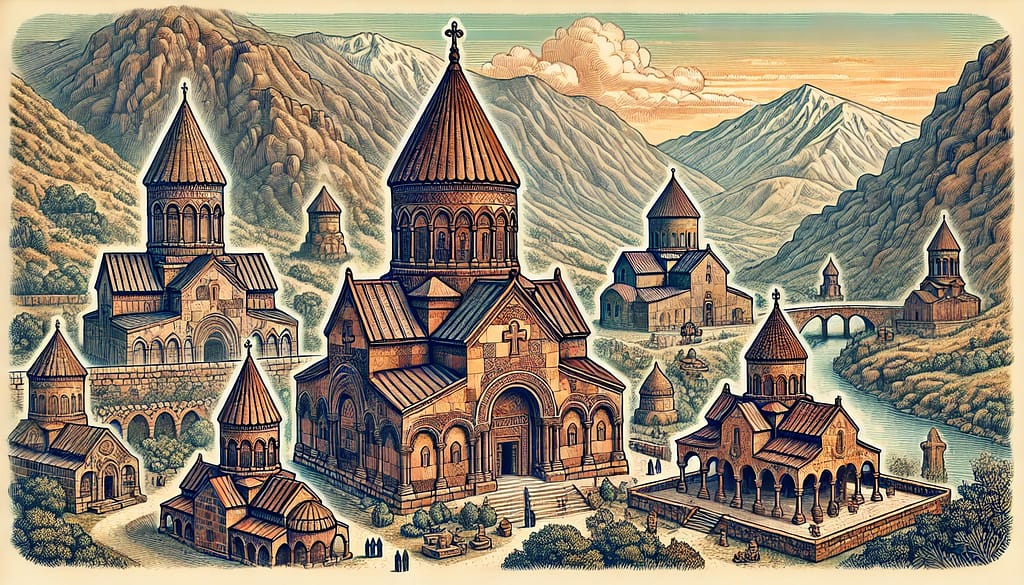
Armenian Monasteries and Architecture
Armenian monasteries and their unique architectural styles have long been symbols of the nation’s rich cultural and religious heritage. These monasteries, often situated in breathtaking natural landscapes, serve as spiritual centers and are remarkable examples of medieval architecture. This section explores some of the most significant Armenian monasteries and the evolution of Armenian architectural styles.
Famous Monasteries
Geghard Monastery (Գեղարդավանք)
- Location: Kotayk Province
- Historical Significance: Geghard Monastery, partially carved out of the adjacent mountain, is a UNESCO World Heritage Site. Founded in the 4th century by Saint Gregory the Illuminator, it was later expanded in the 13th century.
- Architecture: The complex includes several churches and tombs, many of which are cut into the rock, showcasing intricate carvings and detailed khachkars (cross-stones). The name “Geghard” refers to the spear that wounded Jesus, which was kept here for many years.
Haghpat Monastery (Հաղպատավանք)
- Location: Lori Province
- Historical Significance: Founded in the 10th century, Haghpat Monastery is another UNESCO World Heritage Site. It was an important center of learning and culture.
- Architecture: The main church, Surb Nshan (Holy Sign), features traditional Armenian vaulted ceilings and frescoes. The complex also includes a library, refectory, and bell tower, all designed in the distinctive Armenian style.
Tatev Monastery (Տաթևի վանք)
- Location: Syunik Province
- Historical Significance: Founded in the 9th century, Tatev Monastery was a significant center for education and spirituality. It played a crucial role in the cultural and political life of medieval Armenia.
- Architecture: The monastery is perched on a plateau overlooking the Vorotan Gorge. Its main church, Saint Gregory the Illuminator, features a domed basilica design. The complex also includes a library, dining hall, and the famous swinging column, known for its architectural ingenuity.
Noravank Monastery (Նորավանք)
- Location: Vayots Dzor Province
- Historical Significance: Established in the 13th century, Noravank was a major religious and cultural center.
- Architecture: Known for its dramatic red rock backdrop, Noravank’s main church, Surb Astvatsatsin (Holy Mother of God), is renowned for its ornate facade and detailed carvings. The monastery also features two other churches and several khachkars.
Etchmiadzin Cathedral (Էջմիածնի մայր տաճար)
- Location: Armavir Province
- Historical Significance: As the spiritual center of the Armenian Apostolic Church, Etchmiadzin Cathedral is considered the oldest cathedral in the world, founded in 301-303 CE by Saint Gregory the Illuminator.
- Architecture: The cathedral’s design has evolved over the centuries, incorporating elements from various periods. It features a domed cruciform plan with intricate stone carvings and frescoes.
Evolution of Armenian Architectural Styles
Early Christian Period (4th-7th centuries)
- Influences: Early Armenian churches were influenced by Roman and Byzantine architectural styles. The use of basilicas with wooden roofs and apsidal ends was common.
- Examples: The basilica of Saint Hripsime in Vagharshapat and the remains of the church of Zvartnots, which demonstrate the transition to the Armenian style.
Middle Ages (7th-14th centuries)
- Characteristics: The development of the domed hall church, with its characteristic central dome supported by a drum, became a hallmark of Armenian architecture. The use of tufa stone, a volcanic rock, provided a distinct reddish hue.
- Examples: The Cathedral of Ani, the capital of the medieval Armenian kingdom, and the churches of the Sanahin and Haghpat monasteries, which showcase the use of pointed arches and intricate stone carvings.
Late Medieval and Early Modern Periods (15th-18th centuries)
- Innovations: During this period, Armenian architects incorporated defensive features into church designs, reflecting the turbulent times. Bell towers and gavit (narthex) structures became more prominent.
- Examples: The churches of the Sevanavank Monastery on Lake Sevan and the Vank Cathedral in Nor Jugha (New Julfa), Iran, which display a blend of Armenian and Persian architectural elements.
Modern Period (19th century-present)
- Revival and Innovation: The 19th and 20th centuries saw a revival of traditional Armenian architectural forms, often combined with contemporary styles. Diaspora communities also built churches reflecting their unique contexts.
- Examples: The Saint Gregory the Illuminator Cathedral in Yerevan, completed in 2001, which blends modern and traditional elements, and the Armenian Cathedral of the Holy Cross in Akdamar Island, Turkey, restored in the early 2000s.
Architectural Elements
Domes and Drum
- Description: The central dome, often set on a cylindrical drum, is a defining feature of Armenian churches. The drum is usually decorated with blind arcades and sometimes windows, providing light and a sense of height.
- Significance: The dome symbolizes the heavens and creates a focal point for the interior space.
Khachkars (Cross-Stones)
- Description: Khachkars are unique to Armenian religious art, featuring intricately carved crosses, often accompanied by floral and geometric motifs.
- Significance: They serve as memorials, markers, and expressions of faith, with each khachkar being a unique work of art.
Gavit (Narthex)
- Description: The gavit, a type of vestibule or narthex, is often attached to the west end of a church. It serves as a gathering space, lecture hall, or mausoleum.
- Significance: The gavit is unique to Armenian ecclesiastical architecture and reflects the multifunctional nature of church complexes.
Conclusion
Armenian monasteries and their distinctive architecture are not only religious landmarks but also cultural treasures that encapsulate the history, artistry, and spirituality of the Armenian people. These structures, with their unique styles and elements, have survived centuries of change and adversity, standing as enduring symbols of faith and identity. The continued preservation and study of these monasteries and their architecture ensure that the rich heritage of Armenian Christianity remains vibrant and influential for future generations.